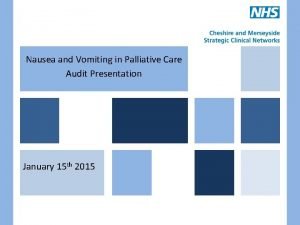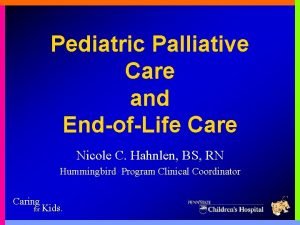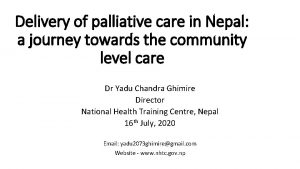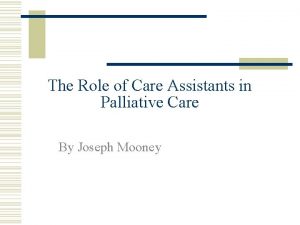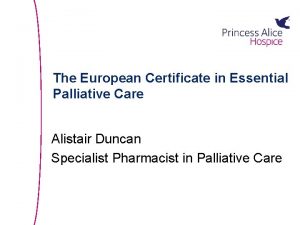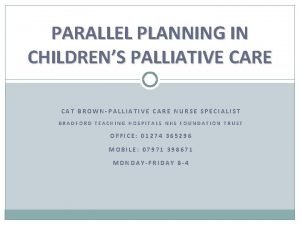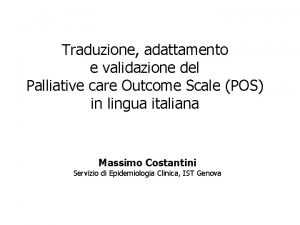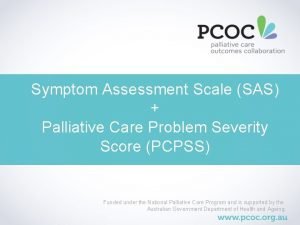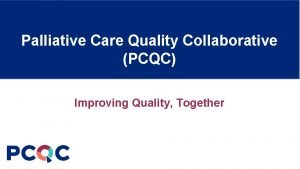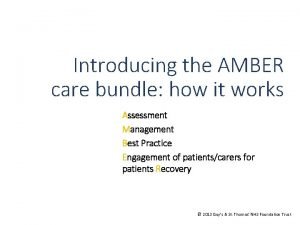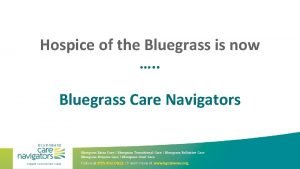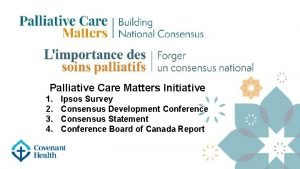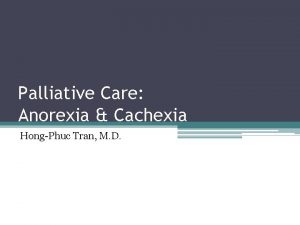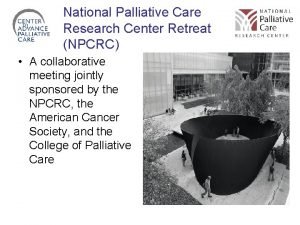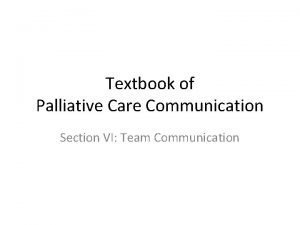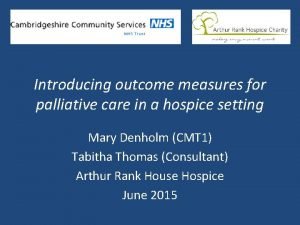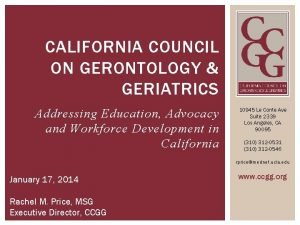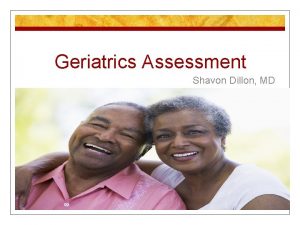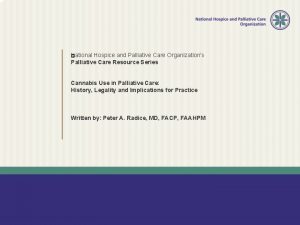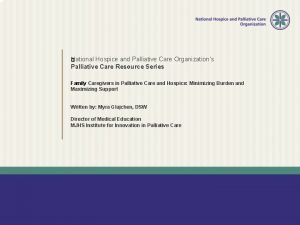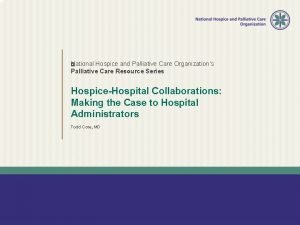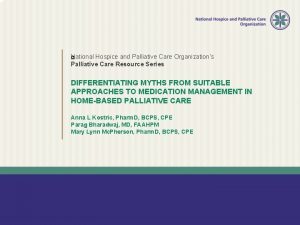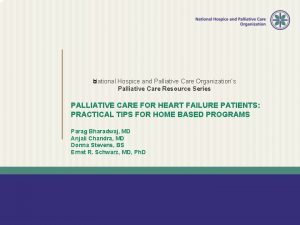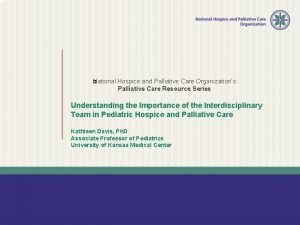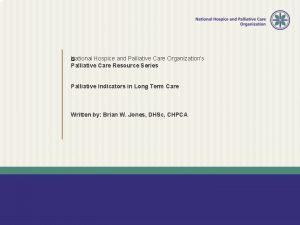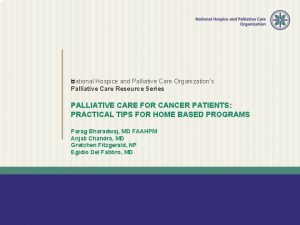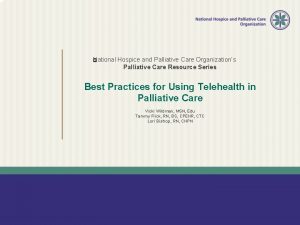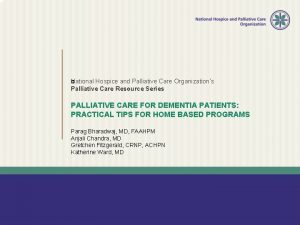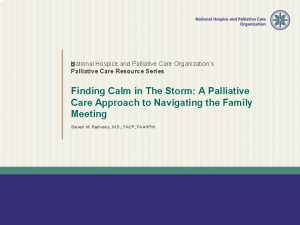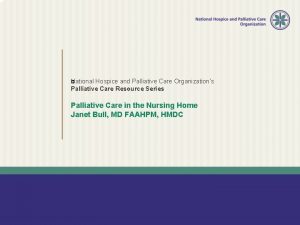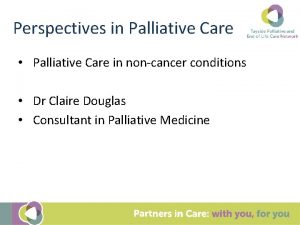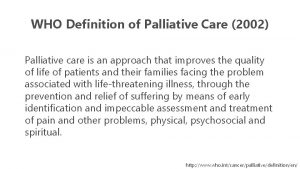Palliative Care and Geriatrics Curriculum Development and Implementation






























- Slides: 30

Palliative Care and Geriatrics: Curriculum Development and Implementation James Hallenbeck, MD Medical Director, VA Hospice Care Center and Stanford Hospice

Questions • Why teach palliative care in the nursing home? • Will physicians-in-training be receptive? • How do I design a curriculum? • How do you teach in this environment?

Why Teach Palliative Care in the Nursing Home? • Great overlap between geriatrics and palliative care • Palliative/EOL care needs are significant • Gives focus to nursing home/geriatric rotation • Certain palliative care principles difficult to teach in other environments

Teaching in the Nursing Home. Special Opportunities • • Relatively stable population Multiple palliative issues to address Patients often have time to talk/teach A great place to experience that there is more to healthcare than acute care

Will Physicians-in-training Be Receptive? • Geriatric training required for internistsnursing home training is not • Barrier of perception- there’s nothing to learn: ‘just old people waiting to die…” • Bad news: we have to work harder to overcome this barrier • Good news: residents are receptive, if they have a good educational experience

Physician Education and Palliative Care • 90% of medical students have some training – Usually didactic- focus on ethics – Symptom management rarely taught • Housestaff education largely part of the “resident sub-culture” – Training/modeling by attending physicians uncommon

Intern Prior Experiences With Death • 6% reported death of 1 st degree relative • 85% reported some training in EOL care N= 27 – only one intern reported any training in symptom management • 55% cared for dying patients only in acute care • 59% had never cared for a dying patient without an IV

Palo Alto VA Intern Hospice Study Lack of EOL skills 1= Knew a little, 5= Knew a lot Mean SD • • • Pain Terminal dyspnea Nausea and Vomiting Physical Changes in Dying Process Psychological Changes in Dying Process Grieving and Dying 2. 00 1. 81 2. 41 1. 70 2. 11 2. 56 . 92. 79 1. 05. 72. 89 1. 12

ITEM Scale: 1= Strongly Disagree, 5= Strongly agree Pre Post Working in a Nursing Home as a physician would be undesirable 3. 9 2. 8 Working with terminally ill patients in Hospice would be undesirable 3. 3 2. 3 Exposure to and training in the care of Nursing Home patients is important 3. 6 4. 6 Exposure to and training in the care of terminally ill (Hospice) patients is important 3. 7 4. 8 Some training in the care of Nursing Home patients should be mandatory for all internists 3. 6 4. 6 Some training in the care of terminally ill patients should be mandatory for all internists. 3. 8 4. 6 P < 0. 001 for all

A Lack of Attending Modeling • 22% had never witnessed an attending discuss advanced directives • 19% had never witnessed an attending share bad news • 44% had never witnessed an attending tell a family member of a death

Designing a Curriculum • Identify your own educational needs- retool as needed • Address learner’s needs/goals • Be explicit about your goals for the learner • Don’t reinvent the wheel – Find and utilize existing educational material

Identifying Your Own Educational Needs • Strengths: your prior training and experience is a precious resource • Weaknesses: – Few have been well trained in palliative care – Even those who have been trained have areas of relative strength and weakness

Educational Resources: • AMA EPEC (Educating Physicians about End of Life Care) Program • American Academy of Hospice and Palliative Medicine – Published curriculum – UNIPACS • Other courses: SFDP, Harvard • Websites: growthhouse. org, eperc. mcw. edu • Textbooks: Oxford Textbook of Palliative Medicine

Adult Learners Are Not Blank Slates • Most residents have their own goals going into a rotation- identify and address them! • Common goals: – Pain, non-pain symptom management, learning what life is like in a nursing home • Uncommon goals: – Learning how to do the definitive incontinence work-up – Learning the fine art of disimpaction

What Are Your Goals for Learners? • Be explicit at beginning of the rotation • Do not try to convince them that they unconsciously want to be nursing home physicians • Do include both medical and non-medical goals

• • Possible Goals Pain management Non-pain symptom management Economics/system issues of nursing home care What life is like in the nursing home – For professionals and residents • Communication skills – Bad news, goal setting, family conferences, conflict resolution • Self-reflective goals – How do they feel about growing old and going to a nursing home?

Domains of Palliative Care Pain Management Non-pain Symptom Management Communication Ethics/Difficult Decisions Psychosocial, Spiritual Care System issues

Educational Resources for Learners • • • Published curricula, selected articles Your own/colleagues handouts Videos, websites Patients Families Other staff Don’t try to go it alone!

Teaching in the Nursing Home. Tricks of the Trade • Link didactic instruction to clinical care – Setting a theme • Establish different learning experiences – – – Nurses aide for a day Aide to different specialty, such as PT ? Patient for a day Journal or other writing Role play communication skills • Role modeling Be Creative!

Role Modeling The Challenge. . . • How does the teacher immerse himself or herself in the role without loosing the learner? • Specifically, how does the teacher facilitate the learner’s involvement with the content, if the teacher is ‘on stage’?

T-L-C EDUCATIONAL MODEL TEACHER LEARNER CONTENT

TEACHER IMMERSED IN CONTENT TEACHER LEARNER PATIENT Danger of role immersion- links to learner weakened

Role Modeling The Context Questions to ask. . . • Part of continuity experience? • How is modeling linked to didactic session(s) • Who are the learners? – ? Mixed skill levels or homogenous • Special learning opportunities? – Unusual situations, patients in nursing home

Setting a theme • Useful especially if seeing patients in series • May link to didactic session, special learner needs and learning opportunities • Assign learner tasks within a theme • Examples: – “Why is this patient here? ” – “Look at the walls and tabletops” – “What does home mean to this patient? ” – “How do different confusional states differ? ”

Before seeing the patient • Reinforce theme, if present • Collect data • Set specific tasks– That you wish to accomplish – Tasks for learners

The Patient Encounter • Goal- immerse yourself totally in the relationship, but continue to involve the learner – Analogous to a good actor- must become the role, but in a manner that allows the audience to see • This so difficult- it’s a life-time practice

The Echo • Definition: A verbal reflection of internal thought processes • Method: – Explain what you are doing – Filter what you don’t want patient to hear – Interpret what you mean so patient/family can understand • Example: patient with red-eyes

The Lateral Pass • Definition: A means of changing roles to facilitate new forms of interaction • Method: make patient (or learner) the teacher • Examples: – “You’re the one with pain, what can you teach us about pain (or dying)”

After the Patient Encounter • Opportunity to re-connect learner to content – “What questions do you have? ” • Opportunity to evaluate – “What did you see? ” – “What was I trying to show when I…” • Time to comment- fill in the blanks • Time to reinforce/summarize

SUMMARY • The nursing home is an excellent place for teaching knowledge and skills rarely taught elsewhere • Teaching can be very rewarding and appreciated by physicians in training • Doing the job well requires a solid knowledge base, planning and skill
 Palliative care vs hospice care
Palliative care vs hospice care Franciscan hospice and palliative care
Franciscan hospice and palliative care Antiemetic pediatric dose
Antiemetic pediatric dose Esasr
Esasr Rugadl
Rugadl Tarek mahdi md
Tarek mahdi md Principles of palliative care
Principles of palliative care Palliative care in nepal
Palliative care in nepal Palliative care assistant
Palliative care assistant European certificate in essential palliative care
European certificate in essential palliative care Parallel planning palliative care
Parallel planning palliative care Hospice traduzione
Hospice traduzione Pcpss
Pcpss Palliative care quality collaborative
Palliative care quality collaborative Just in case bag palliative care
Just in case bag palliative care Amber care
Amber care Goscote palliative care centre
Goscote palliative care centre Barry laird
Barry laird Bluegrass hospice lexington ky
Bluegrass hospice lexington ky Calvary palliative care
Calvary palliative care Anorexia palliative care
Anorexia palliative care Palliative care matters
Palliative care matters Anorexia cachexia palliative care
Anorexia cachexia palliative care Goc palliative care
Goc palliative care Npcrc
Npcrc European delirium association
European delirium association Epeco
Epeco Textbook of palliative care communication
Textbook of palliative care communication Oacc palliative care
Oacc palliative care Ethical issues in palliative care
Ethical issues in palliative care California council on gerontology and geriatrics
California council on gerontology and geriatrics


